I’m aware of four ways that people use to remove Bermuda grass. As far as my experience goes, only two are highly effective though. I’ll share my experiences, moving from the most effective methods to the least.
Glyphosate
Poisoning Bermuda grass with an herbicide that contains glyphosate, which is the active ingredient in the product called Roundup, is extremely effective. This is far and away the most common method of killing Bermuda grass. It’s used by home gardeners, professional landscapers, as well as farmers.
Some years back, I once used glyphosate to kill Bermuda grass that was growing in a crack in my driveway because I couldn’t figure out another way to get rid of it. The spray worked. But because I’m not convinced that glyphosate is harmless, I’ve not used it again.
Fork-and-pull method
My standard method for removing Bermuda is to dig it up. I call it the fork-and-pull method because I find the best Bermuda-digging tool is a garden fork rather than a shovel. Using a fork prevents chopping up the Bermuda grass, which inevitably happens when using a shovel. The problem with chopping up the Bermuda is that the chopped bits will grow into new plants if left in the dirt.
So here’s my general approach when removing Bermuda grass from an area: I work from one side of the area to the other incrementally. I sink the fork in, lean it back and shake it to expose the Bermuda grass with loosened soil around its roots, and then I gently tug on the grass until I can pull it out of the ground without breaking any stems. Sometimes this requires reinserting the fork deeper a few times. Whatever you do, do not yank the grass out such that it breaks.
Here is a young Sharwil avocado tree that had Bermuda growing around it, which I removed a few weeks ago.
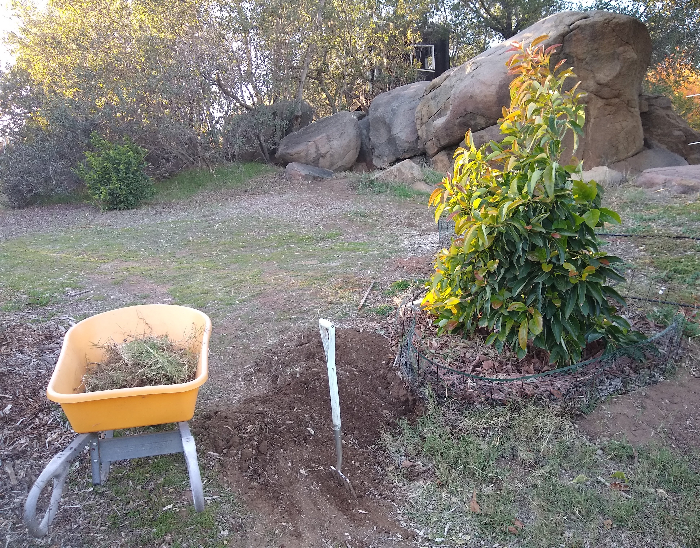

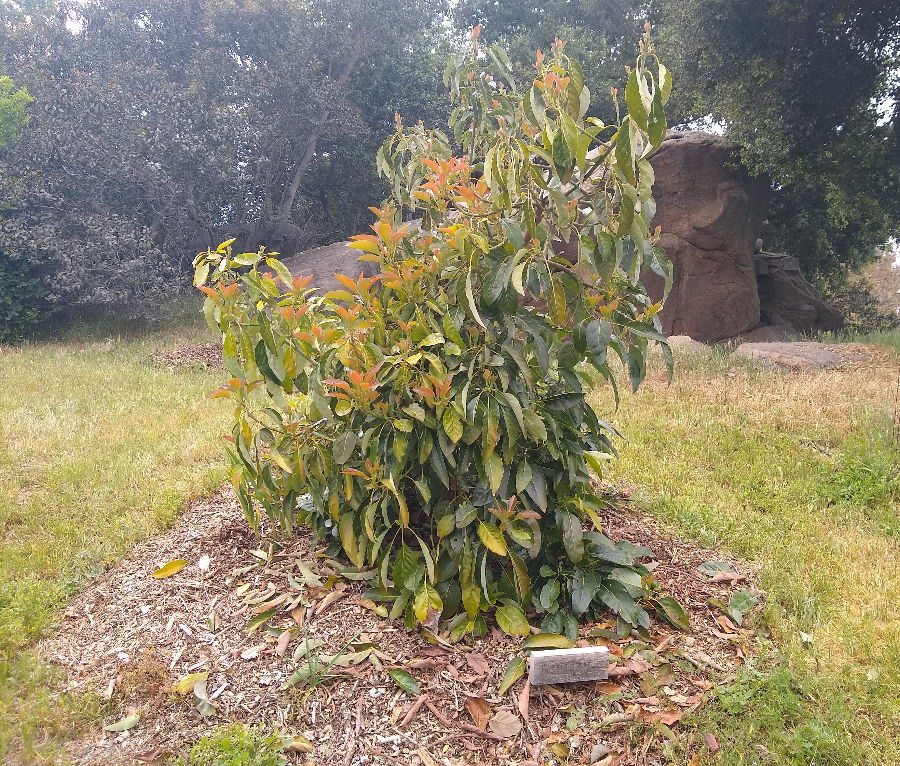
It is slow, systematic work, but if you are hasty or sloppy you will snap the Bermuda stems, leaving some in the dirt. Those stems will grow into new plants and you’ve just wasted all of your time and backache. Do it right or don’t do it at all.
To make this clearer, see this photo of a full piece of Bermuda grass pulled up without breaking any parts:
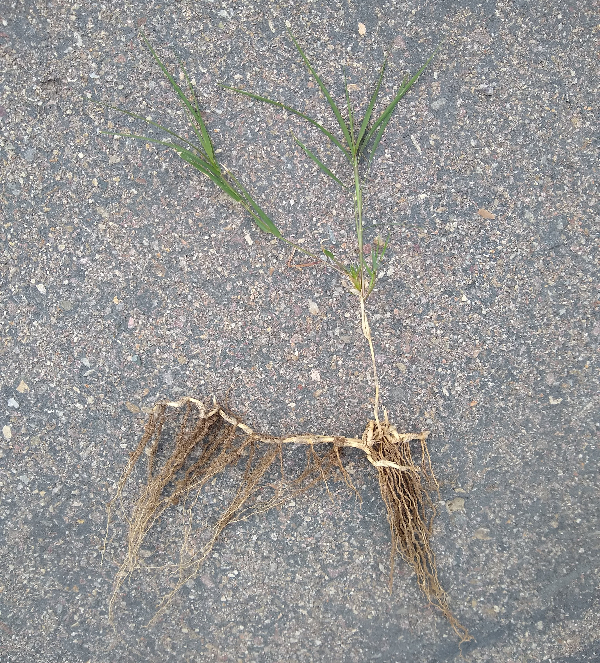
And here is a diagram:
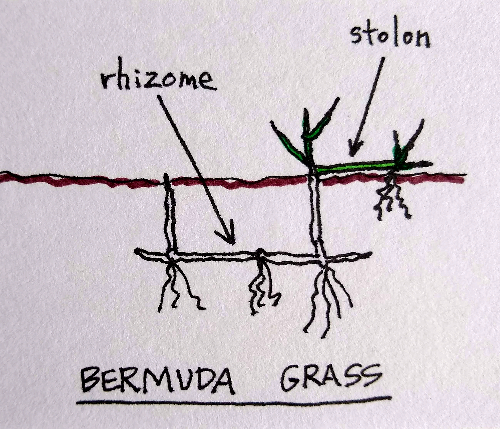
All stems of Bermuda grass are capable of growing and becoming separate, new plants. The stems that are located above ground are usually a very light green color and they are called stolons. The stolons can send roots into the dirt so if they’re separated from the main plant they just become independent plants.
The stems located below ground are white and they are called rhizomes. They can also send out roots, as well as shoot back up to the surface and start growing leaves. Just like the stolons, the rhizomes can be cut off from the main plant and become independent plants. Cutting them off does not kill them.
The digging should be done when the soil is just moist. If it’s wet, it’s too heavy and sticky. If it’s dry, it’s too hard, clumpy and dusty. I like to do Bermuda removal in the late fall through winter, a few days to a few weeks after a rain.
Even being slow and careful, you always miss a few pieces so you must return to the area to check for new sprouts, which are easily removed since the dirt remains fluffy from your forking.
This method is my standard because after using it many times over many years I’ve seen that it thoroughly eliminates Bermuda grass from the area. The only downside is that it requires elbow grease. There’s no free lunch.
Now onward to two methods that I have not seen work as well.
Cover, bury, smother
You can attempt to bury the Bermuda with a combination of cardboard, old carpets, landscape fabric, wood chips, compost, and who knows what else. This can kill the Bermuda that is directly under a thick enough cover. However, any Bermuda near the edges persists and rapidly reinhabits the entire area, even on top of the cover. I’ve seen this happen over and over again.
Also, you cannot plant for a long time, about a year, in an area where you’re trying to bury Bermuda. I’ve seen people be impatient and try to make small planting holes in their cover, and the Bermuda easily finds the holes.
So I think of the cover/bury/smother method as inferior compared to poisoning or digging, but there might be specific situations in which it is still the best approach, for example if you’re trying to kill Bermuda in an entire yard at once and you can cover the whole place and leave it undisturbed for a year.
Heat to death
A final way to get rid of Bermuda is to cover it with clear plastic such that the grass is heated to death. This needs to be done in the summer and in an inland location that gets plenty of sunshine. This is a method I’ve heard of but never seen done. I suspect it sounds more effective than it is in practice since “solarizing” the soil to kill soil-borne pathogens is known to be very difficult to accomplish.
But again, maybe in a place with all of the right conditions it can be an effective approach. I’m still waiting to see the evidence of that.
Bermuda grass is a plant that I respect for its tenacity and its low water needs. I allow it to grow in some parts of my yard because it makes a free groundcover, and my chickens like to eat it. But it’s too competitive for vegetables and young fruit trees. And you can’t turn your back on Bermuda for a single summer or else it expands its territory tenfold!
All of my Yard Posts are listed HERE
I won’t complain if you send me a few dollars to help keep the Yard Posts coming. In fact, I’ll say a huge thank you!

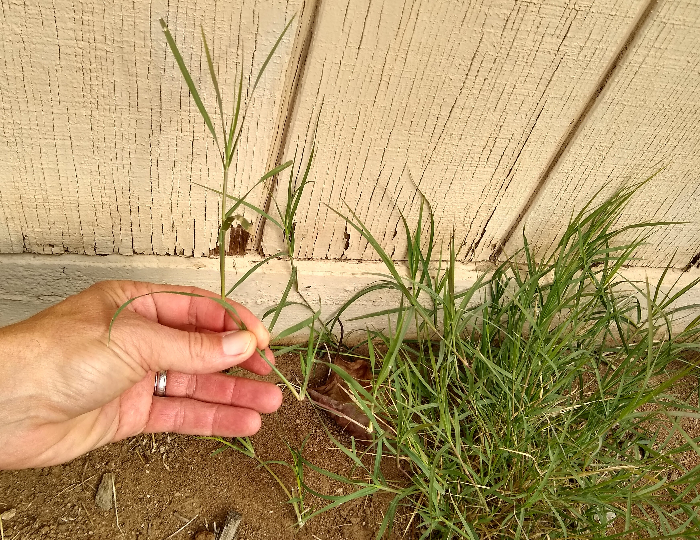


Bain of our existence not to mention the other 10 kinds of weeds on our property! We tried copious amounts of the vinegar, Dawn, water and while it *sort of* seemed to have an effect it was a pain to compose and distribute over large weed areas.
Best article on Bermuda grass that I’ve seen! That stuff is the devil’s weed! I totally agree with you — I’ve tried all the approaches you listed and I also think that the fork-and-pull method is the most effective. Smothering was only effective if I used about 2 ft of mulch, which is not feasible for most situations. I found that using glyphosate required repeated applications, and I definitely do not feel good about that. I had pretty decent success with solarization out here in a part of the Inland Empire where it’s at least 100 degrees for several months every summer, but it was a lot of work to set up and a large part of my yard wasn’t usable for 2 months. I just get a better return for my effort with fork-and-pull. You’re so right, though — there’s no free lunch. I find that it’s better to put in the effort to do things correctly from the get-go, and then reap the rewards of your labor in the long-term.
I agree! Best Article. I have been trying to get rid of mine with digging and mulch. It’s not working, but I’ll keep trying!
My irises are completely overtaken by Bermuda grass is there a spray that will kill it and save our irises?
I had several bulb groups like, spider lillies etc trapped by this devils coil.
I used the harsh product he mentioned which kills it for sure. HOWEVER, to save my blooms I PAINTED it on the grass patches and weed area so systemic killing was fabulous. I had to do a few rounds but …never more.
Hi Greg,
There is in our experience no weed control only weed management. When the dirt is soft is when we pull , after as that becomes more difficult we will spray. I have also used a propane blow torch in appropriate areas. We have also been using with good not great success a product called Avenger. Orange oil based OMRI approved herbicide. No glyphosate, safe around animals . One gallon concentrate Amazon $80 . We although have found it takes two application to be effective. This stuff is not nuclear but it beats using Roundup.
I have successfully removed 100% of the bermuda grass from my property by soaking the ground and carefully digging up all of the roots. I did use a shovel, and I dug deeply. But, I was very methodical about digging one row and then working from there to minimize cutting of grass roots with the shovel. I would suggest doing a second pass to find any missing bits that will sprout if left in place. I would never apply glyphosate anywhere near our property, and especially in soil (or areas that could potentially runoff into soil) where edible plants and fruiting trees grow.
Twenty years ago our home was surrounded with a Bermuda lawn and tried all of the above. My experience with glyphosate is weeds alway come back uglier and more aggressive than before the application. My soil is loaded with all kinds of junk along with the Burmuda so now I dig a shovel full of clod and sift through hardware cloth installed into a wooden frame over a wheel barrel. Slow and tedious but this gives me an opportunity to remove all the other junk in my soil including the Bermuda.
I have also had issues with this nasty weed and what I found effective is to find a runner on top of the soil, place a plastic bag underneath it and then spray that portion of the plant of the plant with Roundup. Remove the plastic once the Roundup has dried. This is a very tedious process and tackles these guys one plant at a time.
An easier method is to get a refillable dauber bottle and just rub it on the plant. That way there is no overspray. I also do this with the periwinkle in my flower beds.
I am highly allergic to Bermuda. Ever since moving into this home, I’ve been having wicked skin reactions! I live on an acre…seems like the only option would be to excavate the top layer, replace with new top soil and seed.
Ha, wishful thinking bermuda roots go deep and will start to mingle with your new sod or seeded lawn..believe me I have tried. Very expensive and does not help but for one year. Now if you have time to check your lawn before cutting ensure none has invaded again weekly at minimum. It is just not so simple especially when neighbors lawn/bermuda seed Flys or creeps into your yard. Harder than dandelions.
It was always a problem in the orange groves. My Dad always called it devils weed. We smothered it with old sacks and sprayed it with smudge oil. That kept it in check but it was always there.
Reminds me of an orange grove I visited a few months ago. They are certified organic so have limited options for dealing with their Bermuda. It looked like they no longer pretended to try to reduce or eliminate it. They just mowed it and allowed it to create a vast carpet between the trees. This was in San Diego’s San Pasqual Valley.
Another plant almost impossible to eradicate is Japanese honeysuckle. Deep roots that go down 8 to 12 inches or deeper. After years of pulling the upper plants, I used a hose nozzle set on blast to get to the deep roots. I guess it’s good for retaining soil on a slope but a spreading menace in a yard.
I used this stuff, sethoxydim. It killed the grass in short order, but it also took down a small, struggling plumeria. It did not seem to harm my mango tree. https://www.domyown.com/hiyield-grass-killer-postemergent-herbicide-p-2516.html
Great topic, thanks for your insight. It comes up between our pavers where I can’t fork and pull. My current method is to pour boiling water over the pavers. Works okay for a year or so, but the grass inevitably comes back.
Hi Patricia,
That is similar to my experience with Bermuda growing in a crack in my driveway. It seems that only the top is killed but the roots are not, and the plant eventually rebounds. I’ve heard that if you consistently remove the regrowth (or kill it with boiling water) that you’ll eventually starve the root system and kill the plant entirely, but I’ve never been able to achieve that.
We have been generally happy with the three areas (total about 400 square feet) we have solarized to clear Bermuda grass lawn for garden expansions. We put down plastic May-October two years in a row to get a decent kill in the San Gabriel Valley. The second year we did allow winter squash vines to grow over some of the plastic. Now, after 2 years of garden production, we have the occasional stray bit to fork out, but nothing unmanageable.
I have the Bermuda grass growing in abundance under and around my low spreading evergreen. So using a chemical or boiling water most likely will kill my evergreen. Over the years I have been pulling it out. I’m beyond frustrated. Any other suggestions would be appreciated. Thinking I’m stuck and will have to continue to pull it out.
I have been fighting Bermuda grass for years in my gardens. I can’t spray chemicals it will kill my bushes. Most invasive weed ever. Only method that works is to dig and pull. Then weeks later check for new growth and pull that. Crazy amount of work.
I agree, Kenny. Crazy amount of work. I’ve been working on some Bermuda in the last few days.
A couple things I’ve noticed to help with the work’s efficiency and effectiveness related to the seasons: Since Bermuda grows only when it’s warm, it is hard to kill at this time because it’s growing so fast. I aim only to keep it from taking plants over in the summer. But then it’s in the winter when I try to dig and pull and actually kill it off in a particular area. It’s important to do this only in winter also because you inevitably disturb the roots of your desired plants during the digging and pulling, but they can handle that better in winter (when it’s rainy and the temperature is mild in Southern California).
Last week, I thought I could get away with digging and pulling Bermuda around a young avocado tree but ended up killing the tree in the process.
Great blog post! I have been in the process of removing my Bermuda grass here in AZ, a 30’x40′ area. I have dug as deeply as possible – peeling it out and sifting like you. I have also used a black tarp/waterproof fabric once each section is complete but also used that to put dirt onto and then dry up/break up the roots and sift. So far, after 4 months, there is not any additional growth I am seeing once I lift the tarp/fabric; I am hoping this process works so I can claim it for fruit trees and garden!
I have been using your method utilizing a pitch fork, but I am concerned that I may be going to deep. Once I get it out I shake off as much soil and worms as I possibly can and flip it upside down elsewhere to dry and kill the roots. Then I dispose of it. It seems though that there are still some roots left even though I am concerned about going too deep. When I take the soil back into place there are what look like tiny roots running all through it. Do I need to get those out also? Are they s part of the Bermuda grass? If so, they go awful deep.
Hi Denise,
You don’t need to remove or even dry out the actual roots of the Bermuda grass, but it takes some time to be able to distinguish roots from rhizome. The plainest distinguishing characteristic is that the roots are much smaller in diameter compared to the rhizomes. You can leave any roots because they can’t grow on their own; only the other parts of the plant can.
I asked an Univ. of Calif. Extension Master Gardiner for advice on how best to get rid of Bermuda.
“Move,” he replied.
Bermuda ain’t allowed in Buzz Fledderjohn’s . . . yard.
100% true!
Im fighting a battle with Bermuda thats been established for over 60 years! I want to put something down that looks better when long and doesnt require so much work.
On a whim, I tried heating some to death, and I am utterly flabbergasted how well it worked. The trick is to use very thin plastic– I used clear .7 mil plastic drop cloth that was $2 on Amazon, and I’ve heard black also works. A thicker opaque plastic tarp was not nearly as effective, and even a slightly thicker clear trashbag was not as good. Weight down the edges, both because the thin plastic blows in the wind and because air getting under cools the grass edges and keeps them alive, and extend the plastic a big past your kill range if you can. I’ve heard that PVC + U shaped staples is a good way to hold the plastic down, but I just used a lot of bricks and rocks. The grass was mostly brown in a day or two and shriveled and rotted in 10 days– I pulled it out this morning mostly using my hands. I am, as the kids say, shook.
Yeah, Jessica! Thanks for the report. Please update if it regrows from the underground parts, and if so, is it vigorous or weak?
Inadvertently, I super heated a flower bed. I saw on Pinterest people made a cute flower bed border with wine bottles. I did this, and killed my plants. Then in the winter my oregano was still alive through freezing spells. It did not dawn on me that the bottles were heating up during the day and releasing the heat at night, keeping the oregano going through the winter, but also super heating the soil and killing my plants in the summer.
I wonder if this would work in the summer to kill off the Bermuda grass. I used wine bottles. I guess you could tell people you were drinking wine, to help rid the earth of Bermuda grass.
Jessica, I would love to know how things went for you in the long run with this method! I have a large raised bed that I was hoping to use soon but it is turning out to be so much work to get the whole thing cleared of a wicked Bermuda infestation through digging. I was thinking of doing solarization of half of it.
Thanks so much for this helpful article! It gives me hope and methods that make sense to me.
I’ve got about 3,000 square feet of lawn that is supposed to be buffalograss, but has some ‘volunteer’ bermuda that I want to remove (some areas are mostly bermuda, while others are 50/50 or less as it spreads out). Buffalograss is another warm-season grass that has runners, so they’re rather intertwined. I really want the buffalograss to ‘win’ though: It’s such a nice grass for this desert area.
Where it’s mostly bermuda, I think I’ll start with the clear plastic to weaken it with the desert heat/uv, and finish off with the fork and pull method (ugh). While the plastic is working, I’ll focus on the 50/50 areas: Removing it while preserving the buffalo is going to be a little dicey. I’m thinking I’ll have to hand-paint herbicide on the leaves because I haven’t found anything that hurts bermuda that doesn’t also hurt buffalo. I’m totally open to suggestions there.
My front yard is also covered with bermuda, but at least there, I start covering spots next to roses and bushes with cartboards, hope, it would starve it out of light.
But in backyard it took over succulent garden covered with gravel. First, I was trying to pull it over gravel, of course it didn’t work. Now I am removing gravel and digging it out.
Hate this grass as much as crab grass. But common bermuda is much tougher.
If you keep at it and remove the stolens as they appear, the rhizome will eventually die, but it may be a persistent task for quite some time. In a single week exposed to the sun it can fully replenish its energy stores and if it became well established it can have enough reserves to keep sending them up all season long.
Glad to know the Chickens like it because I just started a backyard flock in a movable coop and run. I will just start moving it to different sections of the yard and garden. If they will eat all the stolens eventually the rhizomes will run out of sugar trying to push more up to the surface and die.
I found the key to getting rid of it is to let it try to get to the sun and then continuously denying it access to its main source of energy. Every time it creates a stolen it uses stored up energy in the rhizome, which when well established can sometimes be several feet under the ground.
I found this post recently, and after some rain about 2 weeks ago, I decided to try the fork-and-pull method today at my community garden plot in coastal Orange County. We are required to keep the aisles around our plots free of weeds, and we have lots of Bermuda grass. I have 3 aisles either 12 feet or 20 feet with a strip of weeds about 2 feet wide in each. The aisles are hard-packed clay that’s been spread with decomposed granite a few times (to no benefit at all that I can see), so it’s very difficult to sink a fork or shovel, or anything really, into that hard-packed clay. The recent rain helped a little, but I also had to flood the area with a hose several times.
The large clumps of Bermuda were relatively easy and gratifying to dig out. However, there were about a million tiny clumps of grass, and these are much harder to separate out from the wet clay. Each of these clumps was a complete little plant of Bermuda about 2 inches high and an inch wide, and the tiny stems already look like they are producing seed. Perhaps in the poor conditions (dry, low fertility, compaction), they go into seed reproduction mode early. I want to pass inspection and didn’t possibly have the time or energy to pull them all out today, so I pulled out what I could in about 4 hours on my hands and knees in mud. I left about half a million tiny Bermudas in the dug-up dirt. Hope I can get them another time, and hope it’s worth it!
BTW, I didn’t see any rhizomes in the roots, or any lateral branching roots like in your diagram above. Maybe these are too young. I had hoed the surface about a month ago, so the big guys were probably regrowth of some of those. Are the little guys offshoots of the big ones, or just newly sprouted from seed? I sure hope they are not offshoots.
I just found your post and it has confirmed a lot of what I have found. I am wanting to put sod down in my front yard and have tilled to the recommended depth of 6 inches. Ha! Sadly, the roots were not picked up or disposed of right away and just got tilled under where they are starting to regrow. I am just one person trying to rid 2100 square feet of wild Bermuda. I was surprised at first to find the roots go as deep as ten inches or more! I’m using a small hand shovel as I’m looking for the clumps that were tilled under. Also, the person that did the tilling did miss a few areas, ugh. We are in the rainy season here in Texas so it is slow going. I’m able to lay a pallet of sod at a time. So far I’ve got one pallet down and am wondering if I’m fighting a losing battle? You see out side my fenced front yard, on 3 sides there is wild Bermuda and other undesirable weeds. I’m afraid the Bermuda will just creep in and mix with my St Augustine? I’m stubborn and will keep at it until I once again have a nice yard. I used to think nutsedge was my arch enemy until I met the Bermuda! I have even blown out my elbow digging this grass from hell!
About it growing under pavers, I am trying using a seasoning injection needle (for turkey) and inserting that with Round Up into the Bermuda coming up between the pavers.
I have grass to go dug up, thank you for your article and including others comments. Though I don’t hold out much hope it somehow feels better knowing what I am dealing with.
I feel you. I put in a Zen Garden and now want to extend it to my whole yard. Every day I curse the former owner who laid Bermuda sod 25 years ago.
Had a landscape designer and company create a flowerbed in our backyard last fall. They cut up the Bermuda grass and put down some type of herbicide, though I am not sure of what they used. The Bermuda is coming back like crazy. I have bad back and I can’t keep up with getting it out quick enough. I might try the clear plastic solarizing method on some large sections of mulch (future plants planned for those areas). I don’t mind trying the fork method. Do you have a suggestion of the type of fork to purchase? I have never bought or used a similar product so I want to make sure I get the right kind of equipment. Thanks!